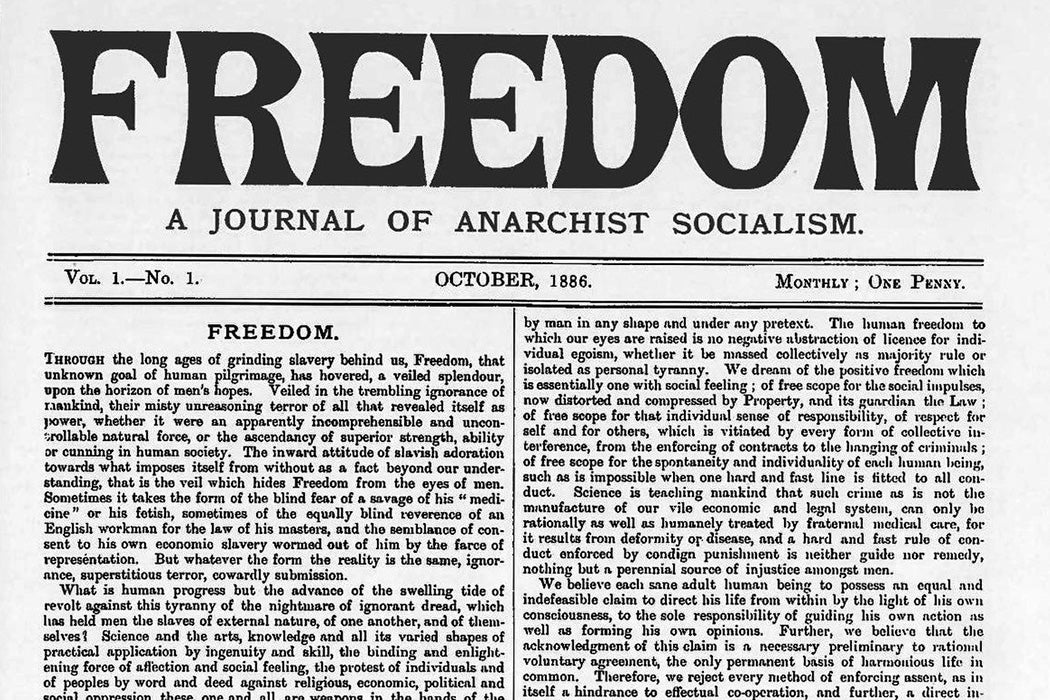Anarchism has rarely gotten good press even though printing was one of the most common occupations of anarchists between the Paris Commune and World War II. While the stock figure of “the anarchist” is the bomb-thrower, political scientist Kathy E. Ferguson suggests that a more representative figure should instead be a printer, “composing stick in hand, standing in front of the type case, making and being made by the material process for producing and circulating words.”
“The anarchists’ ability to create their publications,” Ferguson writes,
through a process that directly embodies their ideas—combining mental and manual work, valuing physical prowess, intellectual insight, and artistic creativity—was and is a source for the political energy sustaining anarchist communities.
Literacy and the printed word were at the heart of the anarchist movement of the late nineteenth century. Communities or schools of anarchists “organized around their publications,” issuing “hundreds of journals, books, pamphlets, leaflets, cards and posters in dozens of languages.” One survey found seventy-nine anarchist journals produced in the US between 1880 and 1940, with circulation ranging from a few hundred to thirty thousand. New York City alone had at least thirty-eight anarchist publications in circulation between 1878 and 1919. During the first Red Scare, the FBI counted 249 radical periodicals in the US in 1919, although not all were anarchist.
With commercial print shops often refusing anarchist material—anarchists were fiercely repressed—anarchists needed their own printers and presses. Through writing and printing, anarchists “could practice what they preached, creating the society for which they longed through the process of calling for it,” writes Ferguson.
Itinerant “tramp printers” freelanced their skills, “sniffing the trail of printer’s ink,” some of them organizing unions and spreading anarchist ideas and practices as they did so. Some these printers were “swifts” or “speedburners” who participated in typesetting races, which measured the speed and accuracy of hand-setting type. In hand-setting, which hasn’t changed much since Gutenberg’s day, a compositor holds a composing stick in one hand and uses the other hand to pull sorts (small wood or metal blocks with a letter or other signifier, like a punctuation mark, on them) from a type case to make lines of words on the composing stick. These are set one-by-one, with spacing blocks between words, as columns of type are built up.
“The work required precision, attention to detail, the ability to read and assemble text upside-down and right-to-left, and the ability to calculate the printer’s point system of measurement,” Ferguson writes.
The assembled type, along with associated blocks for images, charts, and spacing, would be locked up into a form weighing 50 pounds or more. The work was physically challenging and often unhealthy: hot, poorly ventilated shops could be aswirl with lead particles from the metal sorts.
The introduction of the Linotype, which cast hot metal type at the touch, more or less, of a keyboard, in the late 1880s caused an explosion in the number (and editions) of newspapers and other publications. These complicated, expensive machines much reduced the number of compositors, but they took a while to spread out from major newspapers to smaller shops. Manual typesetting survived the introduction of the Linotype and other hot metal machines; it survived phototypesetting in the 1960s and then digital typesetting in the 1980s. Today, letterpress printing carries on the tradition.
Weekly Newsletter
The details of Ferguson’s examination are worth the price of admission (which is zero cents, free, courtesy of JSTOR). She describes presses powered by foot, mule, bicycle, and ram, yes, a male sheep, who eagerly “butted two slabs of wood together to press the type against the paper” in an Arkansas print shop. The London-based Freedom has been publishing since 1886, when it was founded by the famed geographer-explorer Peter Kropotkin and its first editor, Charlotte Wilson. Chicago’s Social Democratic Cooperative Printing Society was made up socialists, anarchists, and union members who owned the press that published the German language Chicagoer Arbeiter-Zeitung (1877–1931), one of the largest circulation radical publications in the US. Arbeiter-Zeitung editor August Spies and one of the paper’s compositors, Adolph Fischer, were two of the five men executed in 1887 after an extraordinary miscarriage of justice following the Haymarket affair. Anarchists to the last, both shouted their defiance to the ultimate power of state before they were hanged.







